This Is What DTF Printing Actually Looks Like
Welcome to the World of DTF: See It, Feel It, Print It
Direct to Film (DTF) printing has taken the custom apparel world by storm. Its vibrant results, flexibility across fabrics, and cost-effective production model have made it a go-to solution for businesses and hobbyists alike. But what does DTF printing actually look like in practice? From the hum of the printer to the peel of the film, let’s walk through the real-life visuals and materials of DTF printing, step-by-step.
1. The DTF Printer in Action
The heart of the process is the DTF printer. Models like the 4-head and 5-head printers are engineered for high-volume, high-resolution output. Watching the printer work is mesmerizing—it layers CMYK pigment ink first, followed by a white underbase that brings opacity and contrast. The film moves steadily through the machine, gradually revealing the design in brilliant color.
2. The Film: Glossy, Clear, and Smooth
The design is printed onto a special DTF hot peel film. This film looks almost like a sheet of clear plastic, but it’s specially coated to receive ink without smudging and to hold fine details perfectly. Once printed, the ink sits atop the film in slightly raised layers, making it easy to see and feel the texture.
3. Hot Melt Powder Application
Next comes the magic ingredient: DTF hot melt powder. The powder is dusted onto the wet ink and then shaken or vibrated to ensure even coverage. Visually, this step adds a chalky, powdery look to the design until the curing process is completed.
4. Curing the Powder
Once coated, the film is heated to melt the powder into an adhesive layer. You can watch the transformation as the powder melts into a glossy sheen, indicating that it’s ready to bond with fabric. Curing is done in an oven or under a heat press, and it gives the print a rubbery, sticky texture.
5. The Transfer: From Film to Fabric
The finished film is then placed ink-side down onto the garment. When pressed at 300–320°F for 10–15 seconds, the design bonds to the fibers. After letting it cool slightly, you peel the film away to reveal a vivid, soft, stretchable print. Watching the design come alive on fabric is truly satisfying.
6. DTF Pigment Inks: Bold and Reliable
DTF pigment inks are formulated to stay bold and bright even after multiple washes. These inks are water-based, eco-friendly, and produce a finish that resists cracking or fading. On film, they appear glossy and rich—especially when laid over the white underbase.
7. Maintenance and Cleaning
Maintaining print quality means keeping your system clean. You’ll regularly use strong cleaning solution for deeper system flushes, and daily cleaning solution to ensure nozzles stay unclogged. The cleaning process itself is simple but essential—preventing ink buildup keeps your prints looking flawless every time.
8. UV DTF: A Visual Shift
Curious about how DTF compares to UV DTF printing? Instead of heat, UV DTF uses UV light to instantly cure ink on film, allowing transfers to hard surfaces like mugs, metal, or plastic. Visually, UV DTF prints often have a glossy, slightly raised finish and offer texture you can feel—ideal for labels, packaging, and promotional items.
9. Before & After Comparisons
Seeing the transformation from digital file to printed film to final garment is one of the best ways to appreciate the process. The before shot shows your flat, digital design. The after shot? A bold, wearable statement that’s ready for sale, gift-giving, or branding.
10. Final Thoughts
DTF printing is more than a technical process—it’s a visual experience. From the vivid pigment ink on film to the satisfying peel and final print reveal, each step is designed for both quality and wow-factor. If you’re ready to see it for yourself, explore our lineup of printers, inks, and supplies at MagicPrint4U and bring your creative vision to life.
